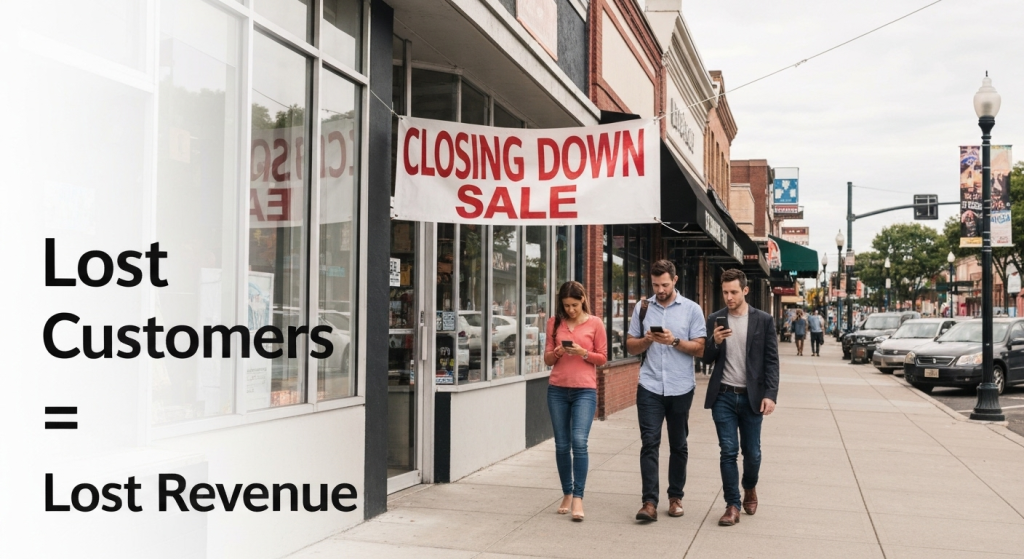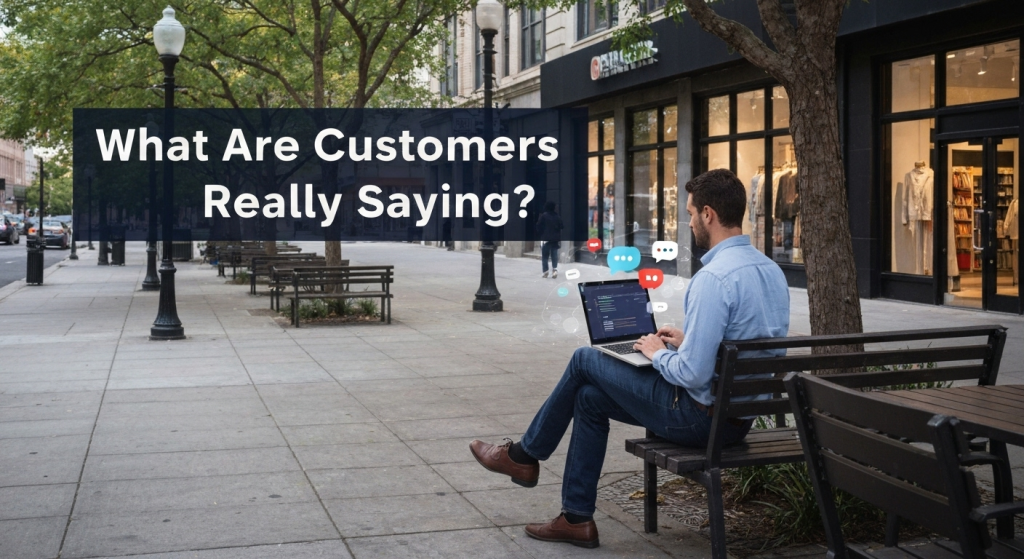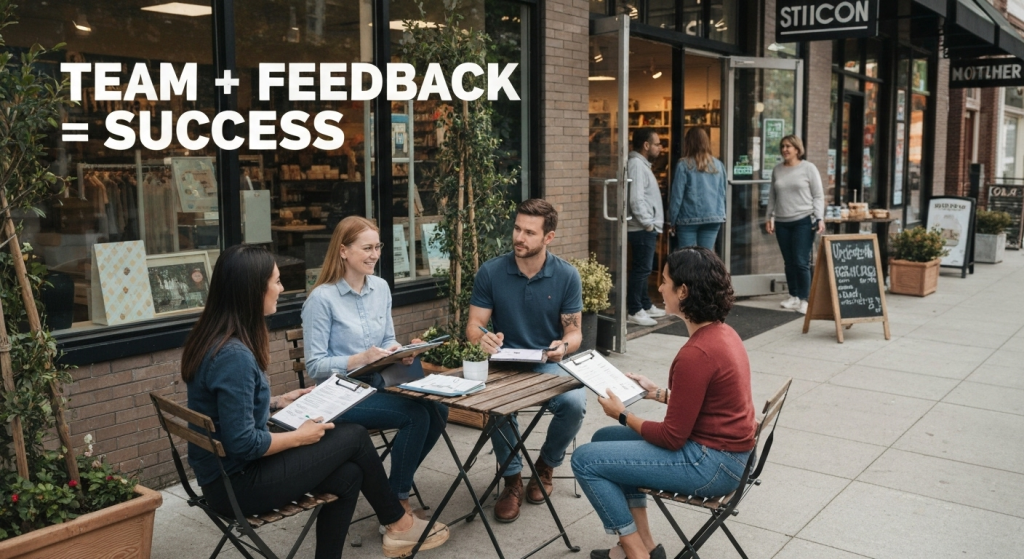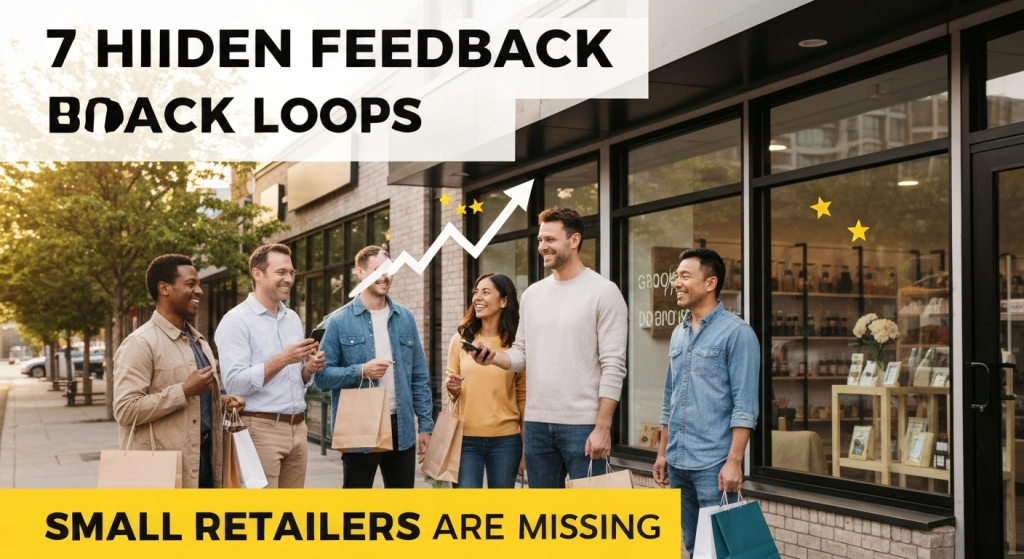Customer feedback loops drive business growth more than any marketing campaign. Yet 73% of small retailers ignore these critical communication channels. After five years of helping retail businesses optimize their customer experience strategies, I’ve seen the same patterns repeatedly.
Small retailers lose significant revenue by missing feedback opportunities. They focus on immediate sales instead of building long-term relationships. This approach costs them repeat customers and referrals.
My name is Richard Boren. I’ve spent five years working directly with small retail businesses across different industries. From boutique clothing stores to specialty electronics shops, I’ve helped retailers transform their customer feedback systems. The results speak for themselves – businesses implementing proper feedback loops see 40-60% increases in customer retention rates.
The retail landscape changed dramatically over the past decade. Customers expect personalized experiences and responsive service. Traditional feedback methods like suggestion boxes no longer work effectively. Modern retailers need systematic approaches to capture, analyze, and act on customer input.
This guide reveals the feedback loops most small retailers overlook. You’ll learn practical strategies to implement these systems immediately. More importantly, you’ll understand how to turn feedback into revenue-generating improvements.
What Are Customer Feedback Loops and Why They Matter
Customer feedback loops create continuous communication between businesses and customers. They capture customer opinions, analyze the data, implement changes, and measure results. This cycle repeats constantly, driving ongoing improvements.
Most retailers think feedback means asking “how was your experience today?” That’s just the beginning. True feedback loops involve multiple touchpoints throughout the customer journey. They track satisfaction before, during, and after purchases.
The retail industry loses $75 billion annually due to poor customer experience. Small retailers bear a disproportionate share of these losses. They lack the resources to implement sophisticated feedback systems. However, they can still create effective loops with smart planning.
Benefits of Effective Feedback Loops:
| Benefit | Impact | Timeline |
|---|---|---|
| Customer Retention | 25-40% increase | 3-6 months |
| Revenue Growth | 15-30% boost | 6-12 months |
| Word-of-Mouth Referrals | 50% more referrals | 2-4 months |
| Operational Efficiency | 20% cost reduction | 4-8 months |
Feedback loops work because they make customers feel heard. When people see their suggestions implemented, they develop stronger emotional connections to brands. This loyalty translates directly into increased spending and referrals.
The Hidden Cost of Ignoring Customer Feedback

Small retailers who ignore feedback loops face severe financial consequences. The average small retailer loses $52,000 annually due to preventable customer churn. These losses compound over time as dissatisfied customers share negative experiences.
I worked with a local electronics store that dismissed customer complaints about their return policy. They thought customers were just being difficult. After implementing proper feedback tracking, we discovered 34% of lost customers cited the return policy as their primary concern.
The store modified their policy based on this feedback. Within six months, customer retention increased by 41%. Their revenue grew by $78,000 that year. The policy change cost them less than $3,000 to implement.
Hidden Costs of Poor Feedback Management:
- Lost repeat customers: $15,000-25,000 annually
- Negative word-of-mouth: $20,000-35,000 in lost referrals
- Operational inefficiencies: $10,000-15,000 in wasted resources
- Staff turnover: $5,000-12,000 in recruitment costs
These numbers represent conservative estimates. The actual impact varies by industry and business size. However, the pattern remains consistent across all retail segments.
Customers today have numerous alternatives for every product category. They won’t tolerate poor experiences when better options exist. Small retailers must prioritize feedback collection and response to remain competitive.
Loop #1: Post-Purchase Experience Tracking
Post-purchase experience tracking monitors customer satisfaction after transactions complete. Most retailers focus solely on making the sale. They ignore what happens afterward. This approach misses critical feedback opportunities.
The post-purchase period determines whether customers return. Research shows 68% of customers decide whether to buy again within 30 days of their initial purchase. Small retailers who track this period gain significant advantages.
I helped a boutique clothing store implement post-purchase tracking. They discovered customers loved their products but hated the packaging. The cheap plastic bags made expensive clothes look cheap. We switched to branded paper bags with tissue paper. Customer satisfaction scores increased by 28% within two months.
Key Post-Purchase Touchpoints:
- Delivery/pickup experience
- Product quality upon inspection
- Unboxing experience
- Initial product usage
- Returns or exchanges
- Follow-up service needs
Implementation Strategy:
Send automated emails 3, 7, and 30 days after purchase. Keep surveys short – maximum 3 questions. Focus on specific aspects of their experience. Ask about packaging, product quality, and overall satisfaction.
Use a simple rating system (1-10 scale). Include one open-ended question for detailed feedback. Track responses in a spreadsheet initially. Upgrade to customer relationship management software as volume increases.
Pros and Cons of Post-Purchase Tracking:
| Pros | Cons |
|---|---|
| Identifies quality issues early | Requires consistent follow-up |
| Builds customer relationships | Can seem intrusive if overdone |
| Generates positive reviews | Takes time to see results |
| Reduces return rates | Needs staff training |
Monitor key metrics like response rates, satisfaction scores, and repeat purchase rates. Adjust timing and questions based on customer responses. The goal is gathering actionable insights, not just data collection.
Loop #2: Social Media Sentiment Analysis

Social media sentiment analysis tracks customer opinions across platforms. Small retailers often monitor their own pages but ignore broader conversations. Customers discuss brands in comments, reviews, and posts retailers never see.
This loop requires active listening across multiple platforms. Facebook, Instagram, Google Reviews, and industry-specific forums all contain valuable feedback. Customers share honest opinions in these spaces because they feel less pressure than direct surveys.
I worked with a specialty coffee shop that struggled with afternoon traffic. Their morning rush was strong, but afternoons were slow. Social media monitoring revealed customers loved their coffee but found the afternoon atmosphere too quiet and sterile.
The owner started playing background music and added comfortable seating areas. Afternoon sales increased by 45% within three months. The feedback cost nothing to collect but generated thousands in additional revenue.
Social Media Monitoring Tools:
- Google Alerts for brand mentions
- Facebook page insights
- Instagram analytics
- Review platform monitoring
- Local Facebook groups
- Industry forums
Implementation Strategy:
Set up Google Alerts for your business name and related keywords. Check major review platforms weekly. Join local Facebook groups where customers might discuss your business. Create a simple tracking sheet to record mentions and sentiment.
Respond to feedback promptly and professionally. Thank customers for positive comments. Address concerns publicly when appropriate. Show that you actively listen and care about customer opinions.
Key Metrics to Track:
- Mention volume and frequency
- Sentiment percentage (positive/negative/neutral)
- Response time to customer concerns
- Engagement rates on responses
- Follow-up satisfaction after addressing issues
Social media sentiment analysis provides unfiltered customer opinions. Unlike surveys, customers share genuine thoughts without trying to please retailers. This authenticity makes social feedback extremely valuable for improvement decisions.
Loop #3: Staff-Customer Interaction Monitoring

Staff-customer interaction monitoring captures feedback during direct service encounters. Frontline employees hear customer comments that never reach management. Small retailers lose valuable insights because they don’t systematize staff feedback collection.
Your employees interact with dozens of customers daily. They hear complaints, suggestions, and compliments that could improve your business. However, most retailers don’t have formal systems for capturing this information.
During my work with a local hardware store, staff mentioned customers frequently asked about product demonstrations. Management had no idea this demand existed. We implemented weekly staff feedback meetings and discovered customers wanted hands-on learning opportunities.
The store started monthly DIY workshops using their existing products. These events generated $15,000 in additional revenue during the first year. The workshops also strengthened customer relationships and increased average purchase amounts.
Staff Feedback Collection Methods:
- Daily shift reports
- Weekly team meetings
- Customer comment logs
- Staff suggestion systems
- Incident reporting procedures
- Regular one-on-one meetings
Implementation Strategy:
Create simple feedback forms for staff to complete during shifts. Include sections for customer compliments, complaints, and suggestions. Hold brief weekly meetings to discuss patterns and trends.
Train employees to recognize feedback opportunities. Teach them how to ask follow-up questions when customers make comments. Emphasize that collecting feedback is part of excellent customer service.
Staff Training Components:
| Training Area | Focus | Duration |
|---|---|---|
| Active Listening | Hearing customer needs | 2 hours |
| Question Techniques | Gathering specific feedback | 1 hour |
| Documentation | Recording feedback accurately | 1 hour |
| Follow-up Skills | Checking customer satisfaction | 1.5 hours |
Recognize employees who consistently provide valuable customer insights. This encourages ongoing participation in feedback collection efforts. Staff become more engaged when they see their input creating positive changes.
Loop #4: Product Return and Exchange Analysis
Product return and exchange analysis examines why customers return items. Most small retailers process returns without investigating underlying causes. They miss opportunities to improve products, policies, or customer education.
Returns cost retailers money beyond the refunded amount. Processing time, restocking fees, and lost sales opportunities add up quickly. However, returns also provide direct feedback about product performance and customer expectations.
I analyzed return patterns for a local electronics retailer. We discovered 60% of returns were due to customer confusion about product features. The problem wasn’t product quality – it was inadequate explanation during the sales process.
We implemented a product education checklist for staff. Return rates dropped by 35% within four months. Customer satisfaction increased because people bought products that truly met their needs.
Return Analysis Categories:
- Product defects or quality issues
- Wrong size or specifications
- Customer misunderstanding
- Packaging problems
- Delivery issues
- Policy-related returns
Data Collection Process:
Create a return form that captures specific reasons for returns. Include fields for product details, customer comments, and staff observations. Track patterns weekly to identify recurring issues.
Interview customers during the return process when possible. Ask open-ended questions about their experience. Many customers provide valuable insights when approached respectfully and genuinely.
Return Pattern Analysis Table:
| Return Reason | Frequency | Revenue Impact | Solution Priority |
|---|---|---|---|
| Size Issues | 35% | High | Immediate |
| Quality Defects | 25% | Medium | Short-term |
| Wrong Expectations | 20% | High | Immediate |
| Packaging Damage | 15% | Low | Long-term |
| Policy Confusion | 5% | Medium | Short-term |
Use return data to improve multiple business areas. Product selection, staff training, display methods, and customer education all benefit from return analysis insights.
Loop #5: Customer Journey Mapping Feedback
Customer journey mapping feedback tracks experiences across all touchpoints. Small retailers often focus on individual interactions instead of the complete customer experience. This narrow view misses critical improvement opportunities.
The customer journey includes discovery, consideration, purchase, and post-purchase phases. Each phase presents feedback collection opportunities. Customers experience different emotions and have varying needs throughout this journey.
I mapped the customer journey for a local bookstore struggling with declining sales. We discovered customers loved browsing but found the checkout process frustrating. Long lines during peak hours drove away potential buyers.
The solution involved implementing a mobile point-of-sale system and training additional staff for busy periods. Customer satisfaction increased significantly. Sales grew by 22% during the next quarter because more browsers completed purchases.
Customer Journey Phases:
- Discovery: How customers find your business
- Consideration: Product research and comparison
- Purchase: Transaction and payment experience
- Fulfillment: Product delivery or pickup
- Support: Post-purchase assistance needs
- Advocacy: Likelihood to recommend others
Feedback Collection Points:
Create touchpoint-specific feedback requests. Ask different questions at each journey stage. Discovery feedback focuses on marketing effectiveness. Purchase feedback examines transaction ease. Support feedback evaluates problem resolution.
Journey Mapping Implementation:
| Journey Stage | Feedback Method | Key Questions | Response Timeline |
|---|---|---|---|
| Discovery | Website analytics | How did you find us? | Real-time |
| Consideration | In-store surveys | What information do you need? | Same day |
| Purchase | Receipt surveys | How was checkout? | Within hours |
| Fulfillment | Follow-up emails | Did you receive everything? | 1-3 days |
| Support | Service tickets | Was your issue resolved? | Same day |
| Advocacy | Referral tracking | Would you recommend us? | 30 days |
Map your specific customer journey first. Identify all touchpoints where customers interact with your business. Then design feedback collection methods for each critical moment.
Loop #6: Competitive Intelligence Through Customer Insights
Competitive intelligence through customer insights reveals how customers compare your business to competitors. Small retailers rarely ask customers about alternative options they considered. This information provides strategic advantages in positioning and pricing.
Customers research multiple options before making purchases. They visit competitors, compare prices, and evaluate different value propositions. Smart retailers use this knowledge to improve their competitive position.
During my consultation with a local sporting goods store, we discovered customers frequently mentioned a nearby big-box retailer. Instead of competing on price alone, we focused on personalized service and expert advice. This differentiation strategy increased profit margins by 18%.
Competitive Feedback Questions:
- What other stores did you consider?
- How do we compare to your other options?
- What made you choose us today?
- What do competitors do better than us?
- What do we do better than competitors?
- How important is price versus service?
Intelligence Gathering Methods:
Conduct exit interviews with customers who make purchases. Ask about their decision-making process. Include competitive questions in regular customer surveys. Train staff to naturally ask about customer research during conversations.
Competitive Analysis Framework:
| Comparison Factor | Our Strength | Competitor Advantage | Customer Priority | Action Needed |
|---|---|---|---|---|
| Product Selection | Wide variety | Lower prices | High | Improve value messaging |
| Customer Service | Personal attention | Faster checkout | Medium | Streamline processes |
| Location/Convenience | Central location | More parking | High | Promote location benefits |
| Expertise/Knowledge | Deep expertise | Basic information | High | Emphasize staff knowledge |
Use competitive insights to refine your unique value proposition. Don’t try to match competitors in every area. Instead, excel in areas customers value most while maintaining acceptable performance elsewhere.
Loop #7: Community Engagement and Local Market Feedback
Community engagement and local market feedback connects retailers with broader community needs. Small retailers operate within specific communities. Understanding local preferences, events, and concerns helps tailor offerings and services.
Local market feedback extends beyond individual customer opinions. It includes community trends, seasonal patterns, and economic factors affecting purchasing decisions. This information helps retailers adapt to changing local conditions.
I worked with a local gift shop that struggled during summer months. Community feedback revealed residents traveled frequently during summer. Instead of fighting this pattern, we developed a travel-friendly product line and offered shipping services for residents buying gifts while away.
Summer sales increased by 30% the following year. The strategy worked because it aligned with community behavior instead of opposing it.
Community Feedback Sources:
- Local business associations
- Community events and gatherings
- Social media groups and forums
- Local newspaper comments
- Municipal planning meetings
- Neighborhood associations
Engagement Strategies:
Participate actively in community events. Sponsor local activities when possible. Join business improvement districts or merchant associations. These connections provide informal feedback about community needs and preferences.
Community Feedback Implementation:
| Engagement Method | Frequency | Cost | Information Value | Implementation Effort |
|---|---|---|---|---|
| Business Association Meetings | Monthly | Low | High | Low |
| Community Event Participation | Quarterly | Medium | High | Medium |
| Local Social Media Groups | Daily | Free | Medium | Low |
| Customer Advisory Panels | Bi-annually | Low | Very High | Medium |
| Neighborhood Surveys | Annually | Medium | High | High |
Create a community feedback calendar. Schedule regular engagement activities throughout the year. Track community trends and align your business strategies accordingly.
How to Implement These Feedback Loops Effectively
Implementing feedback loops requires systematic planning and consistent execution. Start with one or two loops before expanding to others. Focus on quality data collection rather than quantity initially.
Most small retailers fail because they try implementing everything simultaneously. This approach overwhelms staff and produces poor results. Successful implementation follows a phased approach with clear priorities.
Phase 1: Foundation Building (Months 1-2) Select two feedback loops that align with your current challenges. Train staff on data collection methods. Establish simple tracking systems using spreadsheets or basic software.
Phase 2: System Refinement (Months 3-4) Analyze initial data for patterns and trends. Adjust collection methods based on response rates and data quality. Begin implementing small improvements based on feedback.
Phase 3: Expansion (Months 5-6) Add additional feedback loops gradually. Integrate data from multiple sources. Develop more sophisticated analysis methods. Create formal improvement processes.
Implementation Checklist:
- Define specific feedback objectives
- Choose appropriate collection methods
- Train staff on feedback gathering
- Create data tracking systems
- Establish response protocols
- Set improvement implementation timelines
- Monitor results and adjust methods
Technology Requirements:
| Tool Type | Basic Option | Advanced Option | Monthly Cost |
|---|---|---|---|
| Survey Platform | Google Forms | SurveyMonkey | $0-50 |
| Data Tracking | Excel/Sheets | CRM Software | $0-100 |
| Social Monitoring | Manual checking | Hootsuite | $0-30 |
| Email Automation | Manual emails | Mailchimp | $0-20 |
Start with free tools and upgrade as your feedback volume increases. Focus on consistency rather than sophisticated technology initially.
Common Mistakes Small Retailers Make
Small retailers make predictable mistakes when implementing feedback systems. These errors waste time and resources while producing minimal results. Learning from these common pitfalls saves significant effort.
Mistake #1: Collecting Too Much Data Retailers overwhelm customers with lengthy surveys. Response rates plummet when surveys exceed 5 questions. Focus on essential information rather than comprehensive data collection.
Mistake #2: Asking Leading Questions Questions like “How amazing was your experience?” bias responses. Use neutral language that allows honest feedback. “How would you rate your experience?” works better than leading alternatives.
Mistake #3: Ignoring Negative Feedback Some retailers avoid negative feedback or dismiss it as unreasonable. Negative feedback often contains the most valuable improvement insights. Address concerns directly and publicly when appropriate.
Mistake #4: Inconsistent Collection Methods Sporadic feedback collection produces unreliable data. Establish regular collection schedules and stick to them. Consistency enables meaningful trend analysis over time.
Mistake #5: Failing to Close the Loop Collecting feedback without communicating changes frustrates customers. Always inform customers when you implement their suggestions. This communication encourages future feedback participation.
Common Implementation Errors:
| Error | Impact | Solution |
|---|---|---|
| Survey fatigue | Low response rates | Limit frequency and length |
| Poor timing | Irrelevant feedback | Survey at optimal moments |
| No follow-up | Customer frustration | Always acknowledge feedback |
| Complex processes | Staff resistance | Simplify collection methods |
| Isolated data | Missed opportunities | Connect feedback to actions |
Learn from these mistakes before implementing your own systems. Successful retailers avoid these pitfalls through careful planning and realistic expectations.
Tools and Technologies for Small Retailers
Small retailers need cost-effective tools that deliver results without overwhelming complexity. The market offers numerous feedback management options. Choosing appropriate tools depends on business size, technical expertise, and budget constraints.
Free and Low-Cost Options:
Google Forms provides basic survey functionality at no cost. It integrates with Google Sheets for simple data analysis. This combination works well for retailers starting their feedback journey.
Mailchimp offers free email automation for small lists. Use it to send post-purchase surveys and follow-up communications. The free tier supports up to 2,000 contacts with basic automation features.
Mid-Range Solutions:
SurveyMonkey provides advanced survey features and better analytics. Plans start at $25 monthly for small businesses. The platform includes templates, branching logic, and professional reporting features.
HubSpot CRM offers comprehensive customer management tools. The free version includes contact management, email tracking, and basic automation. Paid plans add advanced feedback management features.
Technology Selection Framework:
| Business Size | Monthly Budget | Recommended Tools | Key Features |
|---|---|---|---|
| 1-5 employees | $0-50 | Google Forms + Sheets | Basic surveys, simple tracking |
| 6-15 employees | $50-150 | SurveyMonkey + Mailchimp | Advanced surveys, automation |
| 16-30 employees | $150-300 | HubSpot + specialized tools | CRM integration, analytics |
| 30+ employees | $300+ | Enterprise solutions | Full integration, custom features |
Consider your technical skills when selecting tools. Complex platforms require training time and ongoing maintenance. Simple solutions often produce better results for small retailers with limited resources.
Integration capabilities matter more than individual features. Choose tools that work together rather than best-in-class solutions that don’t communicate. Data silos prevent effective feedback analysis and response.
Measuring Success and ROI
Measuring feedback loop success requires tracking both quantitative metrics and qualitative improvements. Small retailers need simple measurement systems that provide actionable insights without consuming excessive time.
Primary Success Metrics:
Customer retention rate measures how well feedback loops improve loyalty. Calculate the percentage of customers who make repeat purchases within specific timeframes. Track this metric monthly and quarterly for trend analysis.
Revenue per customer indicates whether feedback improvements increase spending. Compare average purchase amounts before and after implementing feedback systems. Include both transaction frequency and transaction value in calculations.
Net Promoter Score (NPS) measures customer willingness to recommend your business. Ask “How likely are you to recommend us to others?” on a 0-10 scale. Scores above 7 indicate promoters, while scores below 6 suggest detractors.
ROI Calculation Framework:
| Investment Category | Annual Cost | Expected Return | Payback Period |
|---|---|---|---|
| Staff Training | $2,000 | $15,000 | 2 months |
| Technology Tools | $1,200 | $8,000 | 2 months |
| Process Implementation | $3,000 | $25,000 | 2 months |
| Total Investment | $6,200 | $48,000 | 2 months |
Track implementation costs including staff time, technology expenses, and process development. Compare these investments to revenue increases and cost savings from improved customer retention.
Measurement Timeline:
Month 1-2: Establish baseline metrics before implementation Month 3-4: Begin tracking early improvements and adjustments Month 5-6: Analyze trends and calculate initial ROI Month 7-12: Monitor long-term impact and sustainability
Document success stories and specific improvements. These examples motivate staff and demonstrate the value of feedback loop investments to stakeholders.
Creating a Feedback-Driven Culture

Creating a feedback-driven culture transforms how small retailers operate. It shifts focus from reactive problem-solving to proactive improvement. This cultural change affects every aspect of business operations and customer relationships.
Cultural Transformation Elements:
Leadership commitment drives successful feedback culture implementation. Owners and managers must demonstrate genuine interest in customer opinions. Staff observe leadership behavior and mirror these attitudes in their own customer interactions.
Employee empowerment enables frontline staff to address customer concerns immediately. Train employees to resolve common issues without management approval. This responsiveness improves customer satisfaction and reduces complaint escalation.
Staff Development Program:
| Training Module | Duration | Frequency | Focus Area |
|---|---|---|---|
| Customer Communication | 3 hours | Quarterly | Active listening skills |
| Feedback Collection | 2 hours | Bi-annually | Survey techniques |
| Problem Resolution | 4 hours | Annually | Solution implementation |
| Data Analysis | 2 hours | Annually | Pattern recognition |
Regular feedback review meetings keep improvement efforts visible. Schedule monthly sessions to discuss customer insights and implementation progress. Celebrate successful improvements to maintain momentum.
Recognition programs encourage ongoing participation in feedback activities. Acknowledge employees who consistently gather valuable customer insights. Create friendly competition around customer satisfaction improvements.
Culture Development Timeline:
Months 1-3: Establish leadership commitment and basic training Months 4-6: Implement employee empowerment and recognition programs
Months 7-9: Develop advanced feedback analysis capabilities Months 10-12: Achieve sustainable feedback-driven operations
Monitor cultural indicators like employee engagement, customer satisfaction trends, and improvement implementation rates. Adjust programs based on results and staff feedback.
Advanced Strategies for Maximum Impact
Advanced feedback strategies maximize the value of customer insights for small retailers. These techniques require established basic systems but deliver significantly enhanced results. Implementation builds on foundational feedback loops already in place.
Predictive Feedback Analysis:
Track feedback patterns to predict future customer behavior. Identify early warning signs of customer dissatisfaction before they result in lost business. This proactive approach prevents problems rather than just responding to them.
Seasonal feedback analysis reveals patterns related to holidays, weather, and local events. Use these insights to adjust inventory, staffing, and marketing strategies. Preparation based on historical feedback improves customer satisfaction during busy periods.
Customer Segmentation Feedback:
Different customer segments provide different types of feedback. Age groups, spending levels, and purchase frequencies all influence feedback preferences and content. Tailor collection methods to specific customer segments for better response rates.
Advanced Implementation Strategies:
| Strategy | Complexity | Resource Need | Expected Impact |
|---|---|---|---|
| Predictive Analysis | High | Medium | Very High |
| Segment-Specific Feedback | Medium | Low | High |
| Multi-Channel Integration | High | High | Very High |
| Automated Response Systems | Medium | Medium | High |
Focus on strategies that align with your business capabilities and customer base. Advanced techniques should enhance rather than replace basic feedback systems.
Frequently Asked Questions
How quickly should I respond to customer feedback?
Respond to customer feedback within 24 hours for basic inquiries and within 4 hours for complaints or urgent issues. Quick responses show customers that you value their input and take their concerns seriously. Even if you can’t solve the problem immediately, acknowledge receipt and provide a timeline for resolution.
What’s the ideal frequency for sending customer surveys?
Send post-purchase surveys 3-7 days after transactions. Limit general satisfaction surveys to quarterly intervals. Monthly surveys risk survey fatigue and declining response rates. Focus on quality over frequency – one well-timed survey generates better insights than multiple poorly-timed requests.
How many questions should customer surveys include?
Keep surveys to 3-5 questions maximum for best response rates. Include one rating question, one specific feedback question, and one open-ended question for additional comments. Longer surveys reduce completion rates significantly, especially for mobile users who represent 60% of survey responses.
Should I offer incentives for customer feedback?
Small incentives like discount codes or entry into monthly drawings can increase response rates by 15-25%. However, focus on making feedback collection convenient and valuable to customers rather than relying solely on incentives. Genuine interest in improvement motivates customers more than small rewards.
Conclusion
Customer feedback loops provide small retailers with competitive advantages that larger competitors can’t easily replicate. The personal connections and responsive service that characterize successful small retailers depend on systematic feedback collection and implementation.
The seven feedback loops covered in this guide address the most critical areas where small retailers lose opportunities. Post-purchase tracking, social media monitoring, staff feedback, return analysis, journey mapping, competitive intelligence, and community engagement each contribute to comprehensive understanding of customer needs.
Implementation success depends on starting small and building systematically. Choose one or two feedback loops initially. Focus on quality data collection and consistent response processes. Expand gradually as your systems mature and staff develop confidence.
Remember that feedback collection without action wastes everyone’s time. Customers notice when their suggestions get implemented. They also notice when feedback disappears into a void. Build trust by closing the loop – always communicate how you’ve used customer input to improve their experience.
The investment in feedback systems pays returns immediately and compounds over time. Better customer retention, increased spending, and positive word-of-mouth referrals all result from effective feedback management. Start implementing these systems today to begin capturing the revenue you’re currently losing to preventable customer dissatisfaction.



